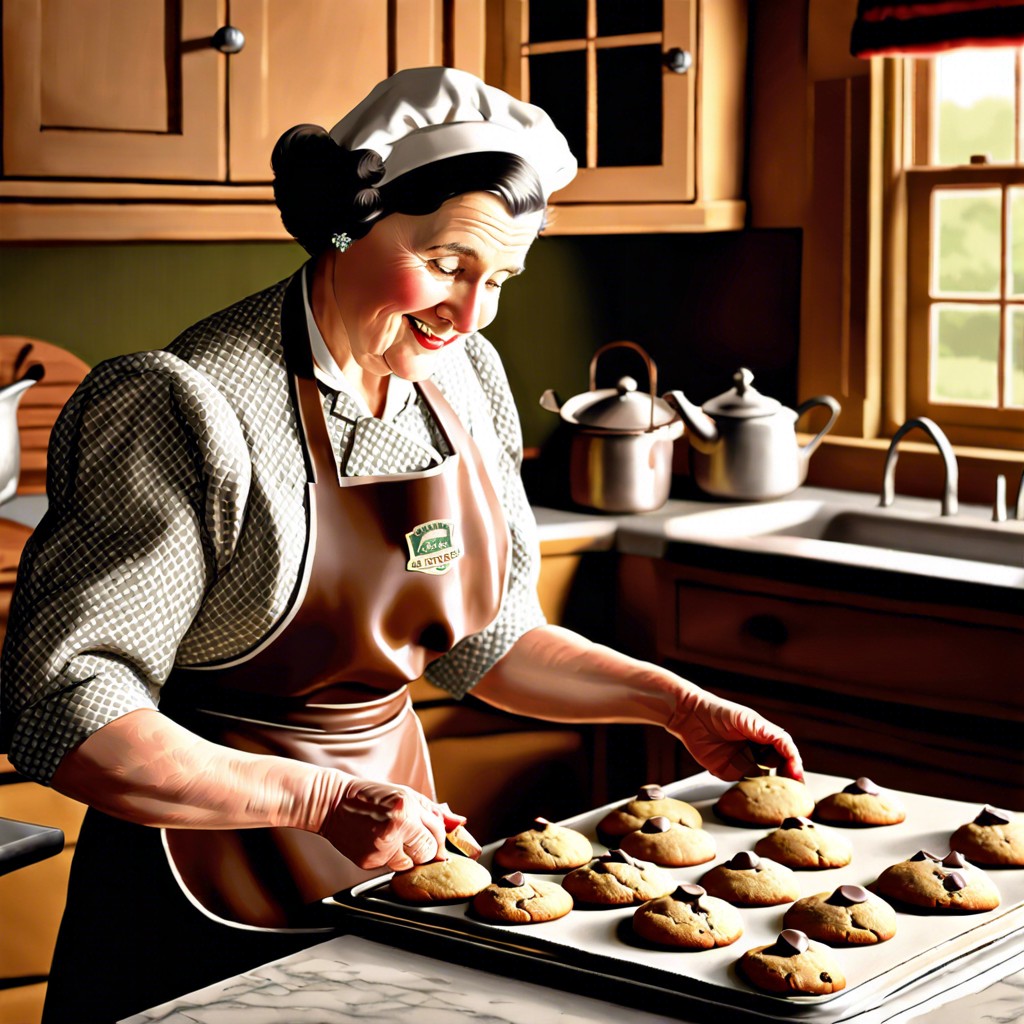Discover the origins of the chocolate chip cookie, a sweet invention that transformed baking and dessert culture.
Key takeaways:
- Ruth Wakefield invented the chocolate chip cookie at the Toll House Inn.
- Ruth Wakefield intentionally added chunks of Nestlé semi-sweet chocolate to her cookie dough.
- The story of the accidental invention of the chocolate chip cookie is a myth.
- Nestlé struck a deal with Ruth Wakefield to print the Toll House recipe on their chocolate bar packaging.
- Chocolate chip cookies have become a symbol of American culinary culture.
Inside
The Originator – Ruth Wakefield and the Toll House Inn

Ruth Wakefield was a dietitian and food lecturer before purchasing a tourist lodge with her husband in Whitman, Massachusetts, circa 1930. This establishment, the Toll House Inn, was where she perfected her culinary skills, often tweaking recipes to the delight of her guests.
Known for its home-cooked style meals, the Toll House Inn provided Wakefield with a platform to experiment and create new dishes. Her background in nutrition and food science informed her approach to recipe development, blending both a scientific and creative mindset.
The inn gained popularity not only for its cozy accommodations but also for its delicious meals, specifically desserts. It was here, within this warm, bustling kitchen, that the chocolate chip cookie—initially termed the “Toll House Chocolate Crunch Cookie”—was born.
How Ruth Wakefield Came to Invent the Chocolate Chip Cookie
Ruth Wakefield was a trained dietician and food lecturer who, along with her husband, owned the Toll House Inn in Massachusetts, a popular spot known for its home-cooked meals. In 1938, while preparing her famous Butter Drop Do cookies, Ruth decided to add a chopped-up bar of Nestlé semi-sweet chocolate, expecting it to melt into the dough. Instead, the chocolate held its shape, softening to a gooey texture. These chunks contrasted with the sweet dough, creating a delightful new treat that guests couldn’t get enough of. Recognizing the appeal of her creation, Ruth named it the “Toll House Chocolate Crunch Cookie,” which quickly became a favorite among the inn’s visitors. Her innovation, fueled by a blend of curiosity and expertise in the kitchen, led to an enduring culinary legacy.
The Accidental Discovery: A Myth Debunked
Contrary to popular belief, the invention of the chocolate chip cookie was not a serendipitous mishap. The story that Ruth Wakefield ran out of nuts for her Butter Drop Do cookies and substituted broken pieces of Nestlé semi-sweet chocolate, expecting it to melt into the batter, has been widely circulated and embellished over the years. However, Wakefield, a seasoned baker with a degree in household arts, was known for her meticulous recipe development and wouldn’t have relied on mere chance for her creations.
She actually intended to create a cookie with distinct chocolate morsels, understanding that the chocolate wouldn’t fully incorporate into the dough. Her goal was innovation, not the result of an accident or ingredient shortage. Wakefield’s culinary expertise and her forward-thinking approach to baking led to the intentional and precise creation of what would become the chocolate chip cookie.
A Deal Is Struck With Nestlé
In the wake of the chocolate chip cookie’s popularity, Ruth Wakefield’s recipe quickly garnered the attention of Nestlé. Sensing a mutually beneficial opportunity, both parties entered into an agreement. Nestlé gained the right to print the Toll House recipe on their chocolate bar’s packaging, an effective marketing strategy that would boost chocolate sales.
In exchange for this, Wakefield received a lifetime supply of Nestlé chocolate, ensuring a steady stash for her cookie creations. This partnership not only cemented the chocolate chip cookie’s place in American baking but also launched it onto a global platform.
It also led to Nestlé’s introduction of the now-iconic Toll House morsels—a convenient, ready-to-use product that eliminated the need for bakers to chop chocolate bars. This ingenuity by Nestlé made it much easier for home bakers to replicate Wakefield’s beloved cookies, contributing to their ubiquitous presence in households nationwide.
The Cultural Significance of Chocolate Chip Cookies
Chocolate chip cookies have transcended their humble beginnings to become an emblem of American culinary culture. They are not merely a treat but a symbol of warmth, home, and comfort. These cookies often serve as a shared language of love and care, often being the first recipe learned by children and a go-to for family gatherings.
They are versatile, allowing for personal interpretation and customization. The simplicity of adding different types of chocolate, nuts, or even spices has invited a spirit of creativity countless individuals adopt in their kitchens.
Their impact extends into the economic sphere as well, with the chocolate chip cookie industry bolstering bakeries, cafes, and the home-baking market. Brand marketing has centered around the nostalgic value of these cookies, often tying them to the quintessential family experience.
Moreover, chocolate chip cookies have enjoyed a prominent role in popular culture, featuring in books, movies, and television shows, often as a comfort food that characters turn to in times of need.
Through bake sales and charity events, they’ve become a currency for community support and philanthropy, showing how food can be a powerful means of bringing people together for a common cause.




